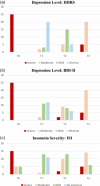Effects of routine repetitive transcranial magnetic stimulation on the sleep duration of patients with treatment-resistant depression: A prospective cohort study
- PMID: 38868089
- PMCID: PMC11114370
- DOI: 10.1002/pcn5.187
Effects of routine repetitive transcranial magnetic stimulation on the sleep duration of patients with treatment-resistant depression: A prospective cohort study
Abstract
Aim: The aim of this study was to evaluate the short-term and long-term effects of routine repetitive transcranial magnetic stimulation (rTMS) on the sleep duration, depressive symptoms, and quality of life of patients with treatment-resistant depression (TRD).
Methods: In this prospective cohort study, 25 participants with TRD were assessed using the Insomnia Severity Index (ISI) and four sleep duration components of the Pittsburgh Sleep Quality Index (PSQI). Depression severity was measured with Hamilton's Depression Rating Scale (HDRS) and Beck's Depression Inventory (BDI-II), and patient-perceived quality of life with the 36-Item Short-Form Survey (SF-36). All of these measures were evaluated at baseline (T0), and immediately (T1), 6 weeks (T2), and 12 weeks (T3) after the end of intervention.
Results: At T1 endpoint, HDRS, BDI, SF-36, ISI, and three PSQI items (time to wake up, time taken to fall asleep, and Real Sleep Time) significantly improved, though these gains were reduced at follow-up endpoints (T2 and T3). Adjusting for confounders (age, sex, occupational status, BMI, and hypnotic medication) revealed that only improvements in HDRS, BDI, and time taken to fall asleep at T1 remained statistically significant. Linear regression analyses showed no significant association between reduced time taken to fall asleep and depression symptoms, suggesting rTMS can independently enhance this parameter, irrespective of depression resolution.
Conclusion: Routine rTMS therapy can potentially enhance sleep duration in TRD individuals, alongside improved depressive symptoms and quality of life. However, these benefits tend to decrease over long-term follow-up, emphasizing a more pronounced short-term efficacy of rTMS.
Keywords: insomnia; major depressive disorders; sleep; transcranial magnetic stimulation; treatment‐resistant depression.
© 2024 The Authors. Psychiatry and Clinical Neurosciences Reports published by John Wiley & Sons Australia, Ltd on behalf of Japanese Society of Psychiatry and Neurology.
Conflict of interest statement
The authors declare no conflicts of interest.
Figures


Similar articles
-
Repetitive transcranial magnetic stimulation for the treatment of major depressive disorder: an evidence-based analysis.Ont Health Technol Assess Ser. 2004;4(7):1-98. Epub 2004 Jun 1. Ont Health Technol Assess Ser. 2004. PMID: 23074457 Free PMC article.
-
Effects of transcranial magnetic stimulation on sleep quality and mood in patients with major depressive disorder.J Clin Sleep Med. 2022 May 1;18(5):1297-1305. doi: 10.5664/jcsm.9846. J Clin Sleep Med. 2022. PMID: 34931606 Free PMC article.
-
[Investigation of the acute effect of bilateral repetitive transcranial magnetic stimulation (rTMS) in therapy resistant major depression patients].Neuropsychopharmacol Hung. 2019 Dec;21(4):179-186. Neuropsychopharmacol Hung. 2019. PMID: 32015195 Hungarian.
-
The effect of repetitive transcranial magnetic stimulation on the Hamilton Depression Rating Scale-17 criterion in patients with major depressive disorder without psychotic features: a systematic review and meta-analysis of intervention studies.BMC Psychol. 2024 Sep 10;12(1):480. doi: 10.1186/s40359-024-01981-6. BMC Psychol. 2024. PMID: 39256851 Free PMC article.
-
Novel Augmentation Strategies in Major Depression.Dan Med J. 2017 Apr;64(4):B5338. Dan Med J. 2017. PMID: 28385173 Review.
References
-
- Mann SK, Malhi NK. Repetitive transcranial magnetic stimulation. Treasure Island (FL): StatPearls Publishing LLC.; 2023. - PubMed
-
- Bouaziz N, Laidi C, Bulteau S, Berjamin C, Thomas F, Moulier V, et al. Real world transcranial magnetic stimulation for major depression: a multisite, naturalistic, retrospective study. J Affect Disord. 2023;326:26–35. - PubMed
-
- Zrenner B, Zrenner C, Gordon PC, Belardinelli P, McDermott EJ, Soekadar SR, et al. Brain oscillation‐synchronized stimulation of the left dorsolateral prefrontal cortex in depression using real‐time EEG‐triggered TMS. Brain Stimul. 2020;13(1):197–205. - PubMed
LinkOut - more resources
Full Text Sources
